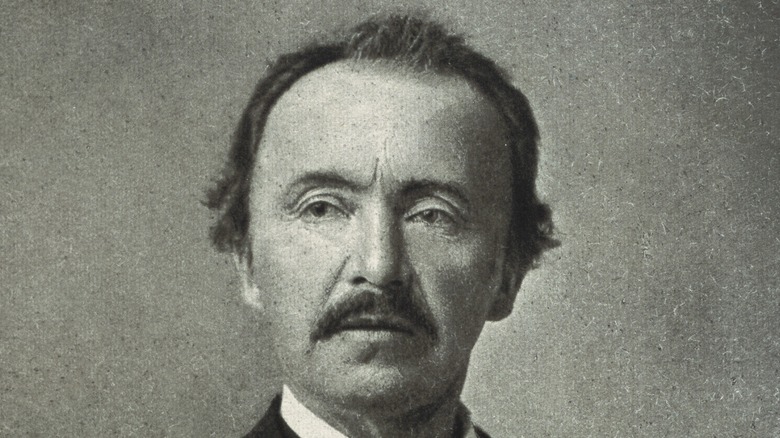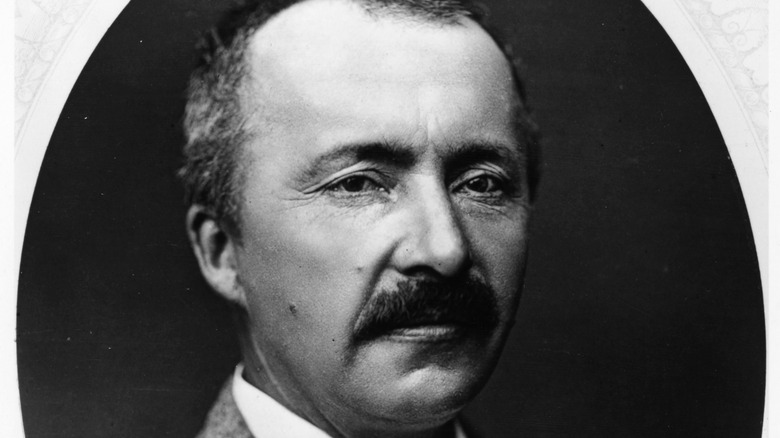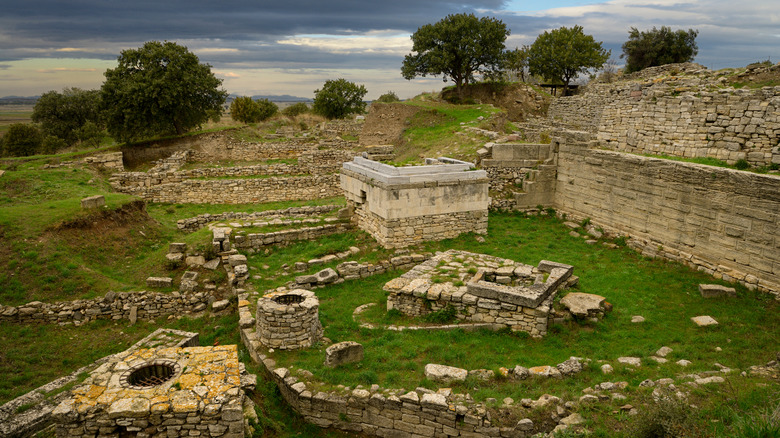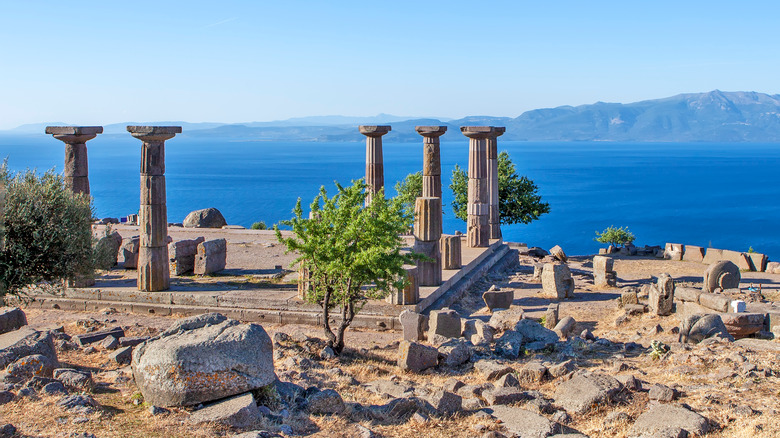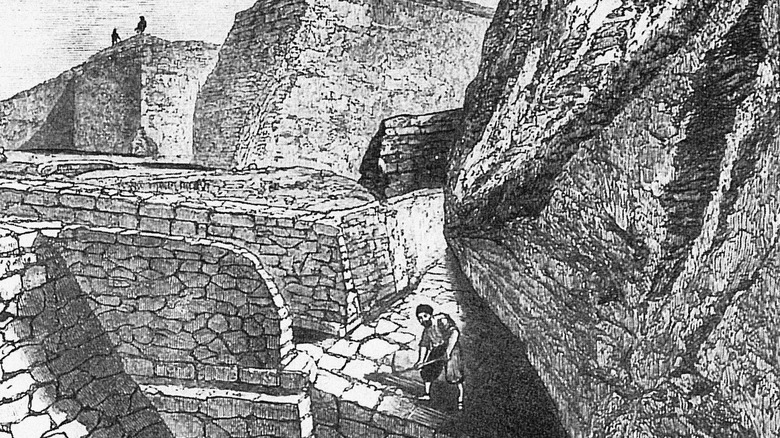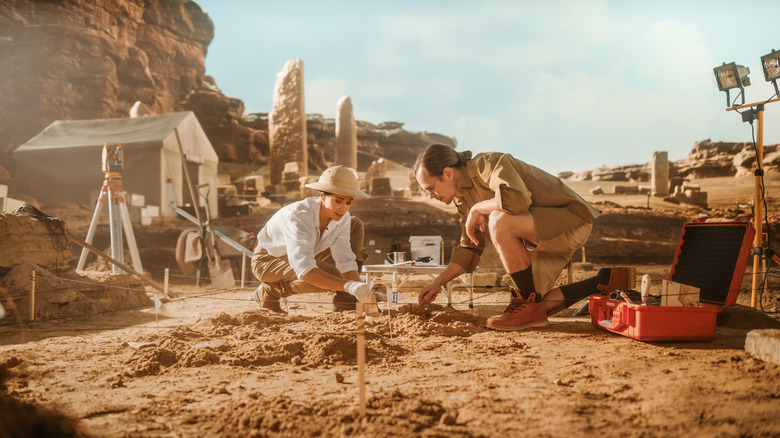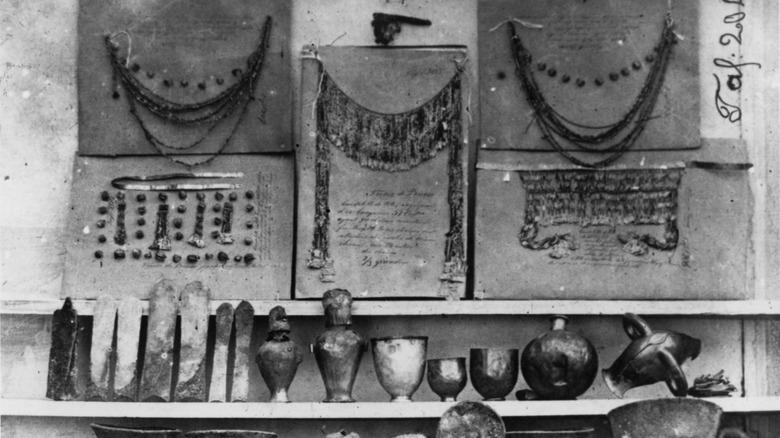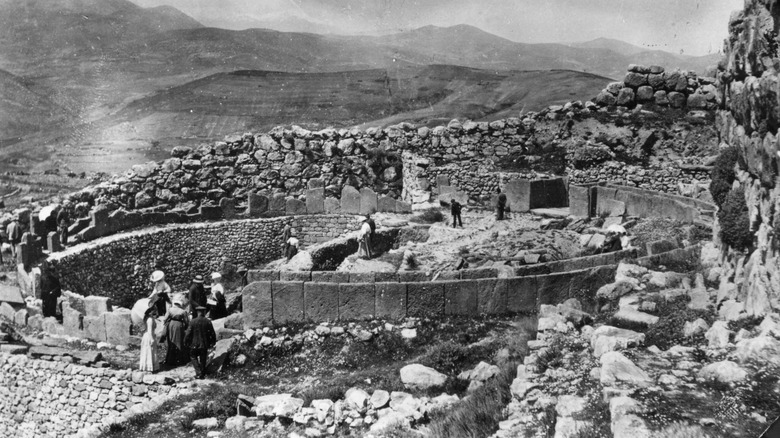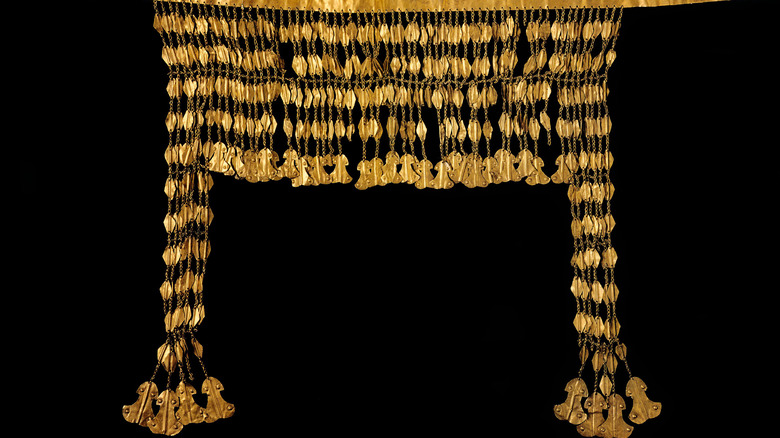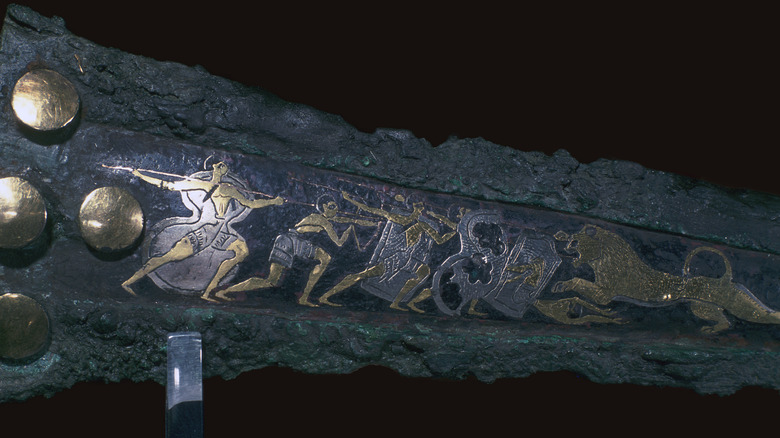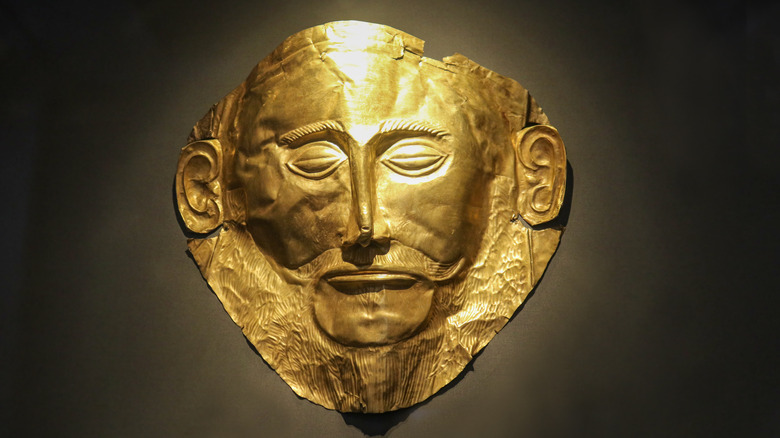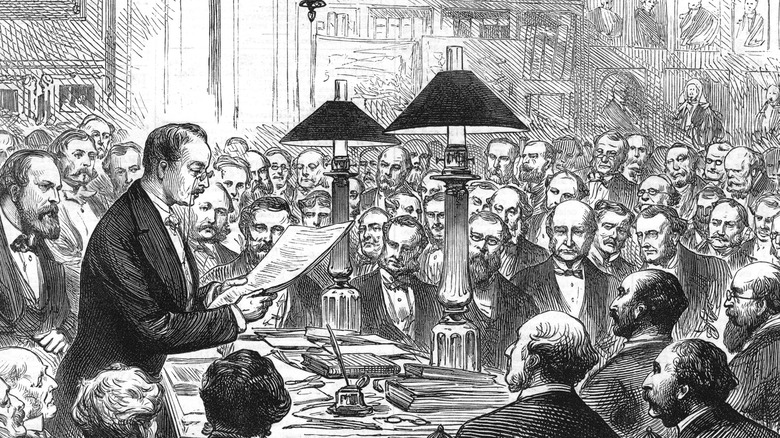The Truth About The Man Who Discovered Troy
If the field of archaeology has a whipping boy, it is Heinrich Schliemann. This late 19th century archaeologist is credited for making some incredible discoveries, including finding the reputed city of Troy, which is central in Greek mythology. However, as Britannica points out, Schliemann's destructive techniques, questionable handling of artifacts, dubious claims, and self-aggrandizing style have tarnished the reputation of the first famous archaeologist in history. Heck, Heinrich Schliemann has become such a meme of prevarication that he is frequently featured as a running joke in popular history podcasts such as "Our Fake History."
So what was the truth of the man who discovered Troy? Is he a cautionary tale for archaeologists on how not to do their jobs? Was he an unrepentant huckster who capitalized on the work of others to make fabulous discoveries? Or was he really the father of modern archaeology? Perhaps "An Archaeologist on the Schliemann Controversy" puts it best, saying "Heinrich Schliemann was a product of the nineteenth century who remains unforgotten today." Let's explore the truth of the man who discovered Troy.
Heinrich Schliemann had Troy on the brain since childhood
According to Britannica, Heinrich Schliemann was born on January 22, 1822 in Neubukow, Mecklenburg-Schwerin, Germany. In Schliemann's autobiographical telling in "Ilios: The city and country of the Trojans," he claimed that his father, a Protestant pastor, had given him a copy of a history book at age 7. The book depicted the Homeric city of Troy burning, which captivated the youth. Schliemann said that his father told him that Troy was just a myth, and Schliemann replied, "Father, if such walls once existed, they cannot possibly have been completely destroyed: vast ruins of them still remain, but they are hidden away beneath the dust of ages." Eventually his father agreed that one day his son would excavate Troy. "Homer and Heinrich Schliemann: Seeing Beyond the Illusion" details how ruins and monuments of the past, such as castles and cemeteries, fascinated the young man. His passion for the mythical past was stoked further when he heard Homer in the original Greek at the age of 14.
This is a well-appointed account of a young man who is destined to discover Troy. But how much of it is true? Later historical scrutiny, as in "An Archaeologist on the Schliemann Controversy" proposes that Schliemann's accounts might have been romantic fancy meant to impress upon readers his passion for his subject. There is no way to distinguish between the truth and falsehoods of Schliemann's youth because he would prove to be loose with facts. What is true, however, is that Heinrich Schliemann did become a successful businessman.
Heinrich Schliemann sold war material to the Russians
There is more firm footing on what we know about Heinrich Schliemann as he entered adulthood. A brief biography, provided in "Homer and Heinrich Schliemann," reveals how he worked as a grocer, cabin boy, and even a mailman. He taught himself multiple languages including French, English, Greek, and Ancient Greek. Scholars believe he probably knew about 18 different languages. These polyglot skills landed him a job with a Dutch company to act as an agent in St. Petersburg, Russia. He was highly successful, but what really made his fortune was selling war goods to the Russian army during the Crimean War. It was during this time, in 1852, that he married his first wife.
But Schliemann wasn't happy. "Heinrich Schliemann: the Man Behind the Masks" reports that in 1856 he wanted to give up the "lies and deception" that business calls for. He was becoming obsessed with ancient Greece. As explained in a "A Brief History of Archaeology," in 1863, at age 43, he pulled back from business to pursue his dreams. He toured the world, and in 1866 gave up business entirely to quest for the mythical city of Troy. Apparently, his wife did not share these ideals and it is speculated in "Homer and Heinrich Schliemann" that she may have mocked him publicly over his fantasies. The marriage ended in divorce, and Schliemann remarried the next year.
Heinrich Schliemann used his money to make himself an archaeologist
Heinrich Schliemann had one resource that pretty much all professional archaeologists did not: money. This gave him the leisure time and resources to begin his lifelong quest to find Troy. He was sure it really had existed. "A Brief History of Archaeology" explains that after his world tour, Schliemann studied archaeology at the University of Paris. He then capped it off with a visit to Greece in 1868. As reported in "Troy," Schliemann saw several sites featured in ancient Greek myth and history. He then received a recommendation to go to the Ottoman side of the Dardanelles where Troy was reputed to be and see Frank Calvert, a British consul and archaeologist who had been conducting excavations on a hill called Hissarlik (sometimes Hisarlik) in a region known as the Troad.
Schliemann made the journey, but before he visited Calvert he attempted some unfruitful excavations at a place called Burnabashi, which was also a suspected site of Troy. He then visited Calvert, who convinced him that his site at Hissarlik was the correct location of fabled Troy. Hissarlik, being a hill, was not natural. It was formed by the detritus of thousands of years of human occupation. Calvert could not continue the excavations for lack of funds. Schliemann, however, had plenty of those.
Did Heinrich Schliemann really discover Troy?
There has been some controversy over who really discovered Troy. "Heinrich Schliemann: the Man Behind the Masks" notes that Heinrich Schliemann was later criticized for taking too much credit for the Hissarlik theory and claiming that he was the first to excavate Troy. "Homer and Heinrich Schliemann" notes that Schliemann and Frank Calvert remained friends and collaborators despite having one brief falling out. This was caused when Schliemann began excavations at Hissarlik without permission. What differentiated Calvert and Schliemann was that Calvert was looking to collect antiquities while Schliemann was far more interested, obsessed even, with proving Troy's historicity.
As "Heinrich Schliemann: Hero or Fraud?" points out, neither Calvert nor Schliemann was the first to identify Hissarlik as Troy. That honor belongs to either Richard Pococke (1740) or Franz Kauffer (1793). John Brunton, a British engineer, was the first to do excavations (albeit briefly) in 1863 and 1865. Whatever the case, Calvert was important since, as told in Schliemann's own account, he owned half of the hill of Hissarlik. Therefore, the dig in part was done with Calvert's blessing. "A Brief History of Archaeology" explains how in October 1871, Schlieman set 80 excavators to work to dig into Hissarlik. A month and a half later, a 33-foot trench unearthed the ruins of a lost city. So the truth of the matter is that Schliemann is not the man who discovered Troy. Rather, he was the man who proved it really existed — well, maybe.
Heinrich Schliemann dug illegally
When Heinrich Schliemann first began his excavations at Hissarlik, it was not without controversy. According to "Heinrich Schliemann: Hero or Fraud?," the archaeologist needed to have a permit from the Ottoman government. However, Schliemann was so eager to get going that he started taking soundings without one and also without telling Frank Calvert. Naturally, when it was found out what he was doing, the Ottoman government made him stop work. Schliemann then wrote to the Ottoman authorities in flowery language, begging them to allow him to resume work. These letters give us insight into Schliemann's style. For example, one letter to the Ottoman government reads:
"...my enthusiasm for the divine poems of Homer, and my love of archaeology, compelled me to make some small excavations over several days. ... Seeing before me the Pergamos of Priam, which learned men of all lands have sought in vain for 20 centuries, my enthusiasm for science carried me away, my fanaticism for archaeology led me astray. I worked in driving rain thinking it was sunny; I thought I had lunched and dined when I had eaten nothing all day; every piece of pottery that I brought to light was for me a new page of history."
Schliemann, as can be seen by this excerpt, certainly had a flare for over exaggeration and hyperbole. Likewise, this zeal is reflective of his highly unorthodox and inadvisable excavation techniques.
Heinrich Schliemann used dynamite to excavate
It should be said at the outset that Heinrich Schliemann was not a professional archaeologist. He had undertaken some training, but he was an amateur. This is reflected in his early excavations. Schliemann dug into the hill of Hissarlik with an uncommendable gusto. For example, according to "Meet Me in Atlantis" he used dynamite to dig out deep trenches in Hissarlik. Then, as reported in "Heinrich Schliemann: Hero or Fraud?," he used crowbars, winches, and battering rams. Britannica notes that during this reckless digging and destroying to get to Troy I (the lowest layer), he actually passed through Troy VI (the sixth layer), which later analysis showed to be the layer where the Homeric era city, from circa 1500 to 1000 B.C., was. In his haste, Schliemann was responsible for the destruction of countless antiquities.
This technique of archaeology, by destruction, is an anathema to archaeologists today, to put it mildly. The Society of American Archaeologists explains that contemporary archaeologists use far less invasive techniques including careful surveys, 3D imaging, and very cautious digging. As "Heinrich Schliemann: Hero or Fraud?" puts it, "He did not bring to the task much initial knowledge of the literature, or much sophistication of thought. He came into archaeology in an intuitive rush, in a mid-life crisis, and the scholarship, reasoning, and excavation technique all had to be developed later."
Heinrich Schliemann's discoveries at Troy were truly fabulous
So far it may seem that Heinrich Schliemann was some sort of scoundrel or clownish caricature. However, he must receive credit because his work rocked not just archaeological circles, but the world itself. "Archaeology as Spectacle" explains how Schliemann did indeed excavate the site of Troy, and in doing so, Schliemann overthrew assumptions about places in mythology. Schliemman had been scorned at for his belief that Homer's epics were historical documents, but his findings offered new windows into the past.
But was what Schliemann found really the same Troy of the "Iliad"? "Heinrich Schliemann: Hero or Fraud?" states that the site matches where ancient civilizations believed Ilium or Troy to be. Yet it is important to remember that while a site is credited as being Troy, it does not, as Schliemann most desperately wanted, prove that the events of the mythology true.
Some Schliemann's findings became quite famous. The most notable was, according to the "Great Archaeologists," a stash of golden objects he reputedly found on May 31, 1873. These he dubbed Priam's Treasure after the fabled king of Troy. While these objects certainly did not belong to Priam since they were found in the Troy II layer, the find drew international recognition and awareness for the importance of archaeology. The event also shows Schliemann's over-willingness to attribute famous mythological figures to the antiquities he found.
Heinrich Schliemann may have falsified his findings
There is no doubt that Heinrich Schliemann's excavations were impressive and important. However, what is troubling about Schliemann is his repeated tendency to falsify his findings. These weren't even mistaken or speculative falsifications such as claiming that Priam's Treasure really belonged to Priam. As "Unearthing the Bronze Age: The Importance and Controversy of Heinrich Schliemann" points out, Schliemann even went so far as to write that his wife was present at the excavation as an archaeological expert even though she wasn't either.
Schliemann also likely took artifacts from various periods and combined them into one set as if they were from the same time period. It seems that he was so determined to prove the historicity of Troy that either he deluded himself into believing his own claims uncritically or he just outright lied. It is hard to tell which. As a result, even during his lifetime Schliemann was accused of being a compulsive liar with experts only believing his claims when it was verified by a third party. As quoted in "Homer: A Guide for the Perplexed," some modern critics went so far as to write that Schliemann "...was ill, like an alcoholic, a child-molester or a dope-fiend."
Yet is this being too tough on Schliemann? Maybe. "Heinrich Schliemann: Hero or Fraud?" explains that Schliemann seemed to be obsessively motivated to prove Troy's historicity. Yet his logic of uncritically labeling his physical findings as proof is just bad archaeology.
Heinrich Schliemann was an artifact smuggler
Sometimes the reason why Schliemann falsified his information was that he was smuggling artifacts illegally. According to "Heinrich Schliemann: Hero or Fraud?" he changed dates of when he found items as well as modifying locations. Much of this was designed to prevent people from figuring out what he was doing — which was removing historic artifacts from its home country and sending it to others.
"How Schliemann Smuggled 'Priam's Treasure' from the Troad to Athens" explains how he falsified papers and lied in letters to cover up his actions. This particular cache, six bags and a chest, infuriated the Ottoman government (according to Homer, Troy and the Turks), and it ordered Schliemann to stop work. Meanwhile, Schliemann tried to sell the artifacts both to the Louvre and the British Museum. In April 1874, a court ordered the collection confiscated. The matter was settled by a court in Athens in 1875, which determined that Schliemann had to pay the Ottoman government 50,000 francs, which was used to build a new archaeological museum in Istanbul. Schliemann continued excavations the next year.
Heinrich Schliemann had accomplices
Sadly, Heinrich Schliemann was notorious for removing antiquities. But is he entirely to blame? "Heinrich Schliemann: Hero or Fraud?" asserts that the answer is no. The article notes that "...he seems to have had plenty of help and encouragement from the diplomatic community — American, Italian, British, and Greek."
This was a common disease of 19th century European imperialism, which was based on the belief that such artifacts were better off in the countries of the "discoverers" rather than in the "uncivilized" places they were created in. Arguments over the ownership of artifacts such as the Elgin marbles are still a controversy today.
Also, it must be considered where Schliemann ultimately came from. He had been a career businessman who had spent millions of his own money on these excavations. Even though he was retired, he certainly remained capitalist and no doubt wanted a return on his investment.
Schliemann continued to make daunting leaps of logic
What seems to be the most aggravating element of Heinrich Schliemann's personality to historians and other scholars is his infuriating leaps in logic. "Heinrich Schliemann: Hero or Fraud?" notes that to his mind, in order to prove the truth of a mythical place he needed to deliver the physical proof. This is seen in what he did with Priam's Treasure, but also is keenly displayed in his 1876 excavations in Mycenae. "The Great Archaeologists" explains that at Mycenae, Schliemann uncovered fabulous artifacts and ruins from prehistoric Greece. Here he discovered among other things, the so-called Treasury of Clytemnestra, which was in actuality a tomb, and then a mask that gained fame as the Mask of Agamemnon.
Schliemann would go on to excavate sites throughout the Mediterranean, including Marathon, Thermopylae, and Alexandria. At this last site, which he worked on in 1888, Schliemann did not have any immediate findings. So, as Archaeology Magazine reports, he likely bought a bust of a woman and then said he found it in his excavations. He called it Cleopatra VII.
Heinrich Schliemann could have been a PR pro
Heinrich Schliemann exercised such self-promotional skill that it would have made showman P.T. Barnum proud. According to "The Great Archaeologists," Schliemann published accounts of his travels in the Homeric Mediterranean even before he made firm discoveries in Hissarlik. In fact, that same year, 1869, Schliemann also received an honorary doctorate from Rostock University for the work and finalized his divorce. In an example of how good Schliemann's sense of self-promotion was, he photographed his second wife Sophia dressed in Priam's Treasure.
Schliemann would boast, "I have uncovered a new world for archaeology." But it can be argued that Schliemann's gift of communication served a larger purpose. As put in "Heinrich Schliemann: Hero or Fraud?," "His lasting achievement was to open up Aegean prehistory, and to create a world wide enthusiasm for archaeology of which we are products and from which we still benefit."
The truth about Schliemann is ultimately not black and white. He was part huckster and part groundbreaker. He was certainly an important archaeologist, but one with asterixes. But one thing everybody can agree on about Heinrich Schliemann is that he was unforgettable.
